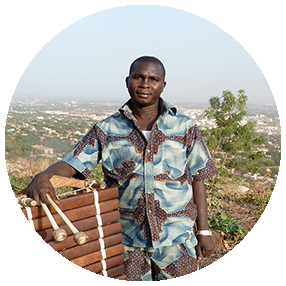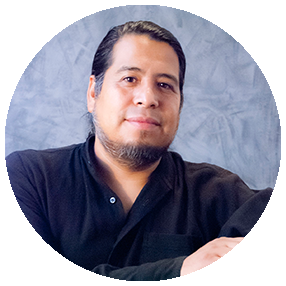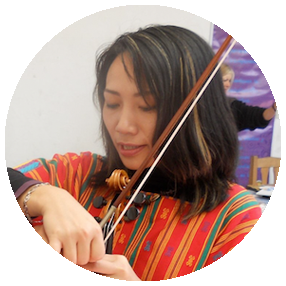THE PROJECT
“Somos negros de la costa”, “We are blacks from the Coast”, (Juvenile Afromexican Musicians in Oaxaca) is a project focused on musical creativity and musical learning modes, as forms of empowerment within emergent political culture of black or Afro-mexican communities in Oaxaca, Mexico. The project has been established in the pueblo Llano Grande La Banda and its objectives are to document and raise consciousness about the role music plays in young juvenile communities. It seeks to enrich its creativity and its performance abilities through music workshops, exploring a musical regeneration as a long term goal. The British Academy has granted the financial aid through Newton grants and the Centre of Research and Higher Studies in Social Anthropology has provided resources in equipment and support to make the workshops possible.
Read more
COORDINATORS
Sergio Javier Navarrete Pellicer
Is a professor of CIESAS (Centre for Research and Higher Studies in Social Anthopology), a member of the Researchers National System (SNI level II), and a visiting scholar at SOAS London. He has a doctorate in Social Anthropology from the University of London and a Masters in Music with an emphasis in Ethnomusicology from the University of Maryland. He plays transversal flute. His areas of specialization are music history and ethnomusicology with an emphasis on Mexico, Guatemala, and Mexican musical traditions in US. He recently concluded the project “Ethnography of Musical Cultures in Oaxaca” (ECMO), and “Cathedral Sound Rituals: A multidisciplinary approachto the music of New Spain” (Conacyt).He is working to set up an intercultural music education program in Oaxaca. As a fellow from the British Academy (2105-2017) and in collaboration with Lucy Durán from SOAS of the University of London, he is running the Project Afromexican musical youth in Oaxaca. Roots, creativity and community: “Somos negros de la costa.“Expected results from this Project are the production of a documentary on Afro-mexican music communities in Oaxaca Mexico and music training of young musicians in these communities with the collaboration of Lucy Duran, Lassana Diabate a Mande griot musician from Mali and Pasatono orchestra from Mexico. His most recent publication is the coordination and edition of a five volume work titled “Ritual sonoro Catedralicio, México: CIESAS, 2013”; and “Maya Achi Marimba Music in Guatemala, Philadelphia, Temple Univeristy Press, 2005.
 Lucy Durán
Lucy Durán
Is Professor of Music at SOAS University of London. She has been researching music of the Mande peoples in Gambia, Senegal, Guinea and Mali for over four decades and much of her work is practice-based research. This includes her films Growing into Music in Mali, viewing online which document how children acquire musical skills in cultures of oral transmission.
In addition to her published writings, she has also produced over 20 albums of West African music including the debut solo albums by both Toumani Diabaté (kora) and Bassekou Kouyaté (ngoni), winning three Grammy nominations. She founded the ‘super griot group’ Trio Da Kali in 2012 to collaborate with the renowned Kronos Quartet, resulting in the award-winning album Ladilikan (2017, World Circuit) co-produced with Kronos’ musical director David Harrington. Her most recent documentary film, on the endangered tradition of girls’ handclapping songs in Mali, TEGERE TULON- HANDCLAPPING SONGS OF MALI, was commissioned by the Kronos Quartet and premiered at their festival in San Francisco in June, 2019. In recognition of Durán’s work, Kronos inducted her into the Kronos Hall of Fame at the end of the festival.
Apart from her academic research and teaching, Durán has a long career as a radio broadcaster (she was regular presenter of BBC Radio 3’s flagship world music programme World Routes). She was consultant for ROOTS – the remake of the famous TV series – advising on Mandinka language, music and culture.
During 2015-16, with a grant from the British Academy Newton Advanced Fellowship, she supervised a multi-media project on Afromexican music from the Costa Chica, Oaxaca, resulting in a documentary film SOMOS NEGROS DE LA COSTA and a CD, FORONTO – AFROAXACA, which she produced with local musicians and two of the member of Trio Da Kali in a mobile studio on a farm outside Llano Grande. The album was released in August 2019.
WORKSHOP MUSICIANS
 Rubén Luengas Pérez*
Rubén Luengas Pérez*
Luengas carried out his studies in ethnomusicology at the National School of Music in the UNAM. However, the core of his academic musical education has its foundations in the concept of Dzbimusicalitydz developed by Mantle Hood. Luengas has been an apprentice of the indigenous musicians of the Mixtec tradition, from whom he has learnt: the language, musical concepts, musical forms, tunings, rituals, and orchestration. He is the youngest professional Bajo quinto (a type of guitar) instrumentalist in the Mixtec region (Oaxaca, Guerrero, and Puebla) who combines oral and written music traditions in his own practice.He is a music composer for a Mixtec Orchestra and Band, and for the DzOrquesta Mexicanadz (a Carlos Chavez concept), as well as for other traditional instruments. He has composed songs, suites, jarabes, and cinema, television and theater scores. Luengas is a researcher specialized in music and the Mixtec language, he has published articles in books, magazines, and records linked with institutions such as: INAH, COLEF, CIESAS, CONACULTA.
*Beneficiary of the National Creator Program 2016 -2019 of the National Fund for Culture and the Arts, Mexico.
 Hawa Kassé Mady Diabaté
Hawa Kassé Mady Diabaté
Hawa Kassé Mady Diabaté is undoubtedly Mali’s finest female voice today, revered at home for her knowledge of the traditional griot repertoire and for her rich and expressive voice and natural vibrato, inherited from her father, Kassé Mady Diabaté. She is rooted in the tradition of Kela where she grew up, a village in southwest Mali famous for its vast repertoire of griot music. Her family lineage is considered to hold the authoritative knowledge of the epic song about Sunjata Keita, founder of the Mali empire in 1235. Hawa is not only the daughter of Mali’s most celebrated male singer, but the great-niece of Mali’s best-known female singer and composer of the 20th century, the late Sira Mory Diabate. She mostly performs at the vibrant wedding parties around Bamako, capital of Mali, that are the main source of income for most Malian musicians. On stage, she has a remarkable poise and understated intensity that makes her unique in the world of traditional Mande music. Since becoming part of Trio Da Kali, she has broken entirely new ground, including an invitation to the India-Africa Summit in New Delhi in 2015 where she opened the celebratory concert with Indian Sufi Gospel creator, Sonam Kulra; in 2016 she performed solo vocals in Terry Riley’s innovative Mali in C with young instrumentalists from the Africa Express project. Hawa is gaining international fame with her contribution to the new film version of ROOTS, released in 2015. Hawa is married to Demba Kouyaté her musician husband and with their five children they share a lively household in Bamako.
 Fodé Lassana Diabaté
Fodé Lassana Diabaté
Is Mali’s most outstanding balafon (22-key xylophone) player – one of Africa’s most brilliant and virtuosic contemporary musicians. He was born in 1971 into a well-known griot family from neighbouring Guinea, and began playing balafon at the age of five, learning from his father, Djelisory Diabaté, a master balafon player who comes from Kindia (Guinea). Lassana later apprenticed himself to some of the celebrated balafon masters of Guinea such as the late, great El Hadj Djeli Sory Kouyaté, also from Kindia, as well as the late Alkali Camara. To this day, Lassana cherishes the now rare recordings of his mentors, whose unique styles continue to be an important inspiration to him.
Lassana has a long professional career as accompanist to Mali’s divas such as Babani Koné and Ami Koita. He has recorded with many of Mali’s top artists such as Toumani Diabaté, Salif Keita, Tiken Jah Fakoly, Kasse Mady Diabaté and Bassekou Kouyaté. He was a member of the Grammy-nominated Mali-Cuba collaboration, Afrocubism. He has done collaborations with international artists across a number of genres including jazz and Latin music. He is the leader of the new group Da Kali, a trio of Malian griots whose aim is to bring back forgotten repertoires and styles of the Mande griot repertoire. They were founded in 2012 under the sponsorship of the Aga Khan Music Initiative, to collaborate with the Kronos String Quartet, a stunning project which had its debut concert at the Clarise Smith Centre for Performing Arts, Maryland, in February 2014.
Da Kali have performed to great critical acclaim in the Royal Albert Hall for the Proms Festival (2013), the South Bank for the London Jazz Festival, and Paris’ Theatre de la Ville, and are touring the UK in February 2015 in the series ‘Making Tracks’ http://www.makingtrackslive.org.uk/#/trio-dakali/4584845754. Da Kali’s eponymous debut album, released by World Circuit Records in March 2015, includes two remarkable balafon solos by Lassana.
Lassana’s style of playing balafon is unique in its range of expressive tone and lyrical melodies, and he has perfected the complex art of carving – and tuning – the smoked rosewood keys of the balafon, a craft he learnt in Guinea. Of his many collaborations, Lassana’s experience of working with the Kronos Quartet has left the most lasting impression. ‘The bowed instruments of the quartet are the perfect counterbalance to the percussive nature of the balafon’ he comments. ‘They bring out its lyrical qualities and the more subtle side to our music, which often gets ignored. The way that Kronos have been able to capture the soul of our music is truly remarkable’.
When Lassana was asked to compose a piece for Kronos, he was thrilled by the possibilities it offered.
‘The balafon was once played for our kings, before colonial times’ he says.
‘It was the instrument of the court. Sunjata Keita, the famous king who founded the Mali Empire more than 700 years ago, went to sleep and woke up to the sound of balafon. I have decided to compose a piece about Sunjata’s entourage, in four movements, each one focusing on one of the instruments of the quartet. Sunjata himself has several well-known tunes, but for this new piece, I am dedicating each movement to a different character in the story: Susu Sumaworo, the sorcerer king who tried to take power away from Sunjata (viola); Sunjata’s mother, Sogolon Kone, who came from the land of Do, where the music sounds like the blues (2nd violin); Sunjata’s beautiful sister, Nana Triban, who seduced Sumaworo in order to understand his secrets in battle (cello); and finally, Bala Faseke Kouyate, Sunjata’s balafon player, and his loyal friend and advisor (1st violin).’
Although these are brand new compositions, they are steeped in the interlocking idioms of the balafon from Guinea, one of Africa’s most remarkable oral traditions.
 Edgar Jesús Serralde Mayer
Edgar Jesús Serralde Mayer
Serralde musical training began during childhood when he joined Ollin Yoliztli, the school of artistic initiation, and specialized in folkloric instruments. He then continued his training of middle school and high school in the CEDART Diego Rivera of INBA. He continued to study in the Music Faculty of the UNAM (National Autonomous Mexican University) and concluded his Bachelor’s degree in Ethnomusicology. During his trajectory as a music interpreter he has participated in a variety of groupings and musical projects, such as “Jabalí, música tradicional de occidente” (Wild Boar, traditional music from the West), the typical orchestra “Sonecitos de la Tierra ” (Sonesitos of the Land) and the group “Doble Eje” (Double Axis), among others. His participation in such associations permitted his exposure to diverse forums, festivals, and sceneries throughout national territory, in addition to acces to the radio, television, and film(cinema). At the moment Serralde divides his professional activities between ethnographic research as a member of the project “Ritual Sonoro” (Resounding Ritual) based in CIESAS, Oaxaca, and personal projects. He is a member of the groups: La mar ensemble, Pasatono Orquesta and Orquesta Mexicana (a native instruments orchestra designed by Carlos Chávez).
 Natalia Arroyo
Natalia Arroyo
Native of Ensenada, Southern California, Rodriguez has been playing the violin for 20 years along with composing and singing. She has since been a prominent figure in the world’s great stages, some of the more famous ones are: Smithsonian Folk Festival 2009 in Washington, The Music Festival in Pretoria Sudáfrica, The Fall Festival in Paris, The Verk Berkhart Festival in Austria, The Music Festival in Bogotá Colombia, Festival of the Arts in Santo Domingo República Dominicana, International Music Festival in Buenos Aires, Argentina, Rainforest World music Festival in Malaysia, Festival of the Arts in Costa Rica and in México. She has participated in 5 record label productions among which Son of Wood collective stands out, here she takes the role of a violinist and singer along with César Olguín, Eugenia León, Piano Xarocho by Claudia Calderón and the Tierra Mestiza Ensamble by Gerardo Tamez. Ever since 2013 she has worked with the Ecological Group of the conservation of the Islands of Ensenada, Southern California, carrying out workshops and compositions in different islands of the state. She works in the project Music Nest in Tezoatlán, Oaxaca and collaborated with the traditional music group, Pasatono. London’s BBC Radio station dedicated a whole program to her work as a soloist. She won the ‘Luna del Auditorio’ (Auditoriums moon) in 2015 with the jarocho Son de Madera quartet. And recently she received a grant to assist an artistic residence in New York to work in the field of composition and interpretation of violin music pieces.
 Rie Watanabe
Rie Watanabe
In 1992, after having studied in The Juilliard School of Music in New York, Rie graduated from Western Illinois University, Illinois with the cum laude honorary prize. She obtained her masters degree at the Naruto University of Education in Japan.Rie Watanabe has performed violin solo recitals, and has also played in chamber music concerts in the United States, Canada, Australia, Europe, and Japan. In the year 2000, she received the “Artist of the year” prize from the Tokushima prefecture. She has participated as an invited artist in the Niagara International Chamber Music Festival and continues to give classes in the International School for Musical Arts in Niagara, Canada. In 2007, she became familiar with traditional music from the highlands of Chiapas. She is a member of the “Sak Tzevul” (Thunder in Mayan Tsotsil language) music group. Rie has dedicated herself to disseminate a “fusion” music that comes from the highlands of Chiapas and classical music from Japan, and devotes herself to teach music to children and youth in Chiapas, Mexico. She has played with Sak Tzevul in different Mayan pueblos as well as in important festivals such as the International Cervantino Festival en Guanajuato, El Tajin, and others in Mexico. In 2010, the group made its debut in the U.S in the National Museum of Mexican Art in Chicago. In 2013 she carried out tours in Tokyo, Osaka, and other cities in Japan. Since 2014, she has been collaborating with the Pasatono orchestra in Oaxaca, imparting workshops within the project “Musical Nests” in Tezoatlan, Oaxaca; and she has also participated in concerts with Pasatono orchestra.
 Pablo Alberto Pérez Márquez
Pablo Alberto Pérez Márquez
Born in Mexico city, he is a percussionist, Photographer and writer who lives in Oaxaca city since 2011. His early music studies were in the Yamaha Academy and in Fermatta Academy. During that time he joined different hard rock bands. In 2001 He entered the School of Music at the National Autonomous University of México (UNAM) where he studied Ethnomusicology and joined traditional music bands like “Orquesta Típica Sonecitos de la Tierra”, “Jaranero” and Cuinique”. At present he is a percussionist of “Pasatono Orchestra” and of “Carlos chávez Mexican Orchestra”. He has recorded two records, and music tracks for films and documentaries with Pasatono Orchestra. With this orchestra he has travelled abroad to United states. For the past 20 years he has collaborated 20 years in Museum exhibitions such as “Senderos de la Música Tradicional Mexicana” in the Popular Cultures National Museum. As a photographer he has presented his work in two exhibitions in Oaxaca City.
Ignacio Carrillo
(participant in initial phase of the Project)
Percussionist specialized in Afrocaribbean music. Member of the well known group in Oaxaca Lorena y los Alebrijes. He has produced two records with this group.
LOCAL MUSICIANS
 Chogo Prudente “El bandeño”
Chogo Prudente “El bandeño”
Born in Santiago Llano Grande “La Banda” Jamiltepec, Oaxaca, Mexico. Chogo is a self taught troubadour and a composer of songs inspired in nature, the coast, love, women, the land and its people and culture. He is a committed promoter of the culture of the region where he was born. He enjoys singing in small community gatherings in the streets or in other bigger settings and occasions. Life is just a passage and by the way we pass and sing.
 Víctor Hugo Laredo Morales
Víctor Hugo Laredo Morales
Victor Hugo, was born fifty three years ago in Santiago Llano Grande “La banda” Jamiltepec, Oaxaca, México. He studied primary level at the community school, where the Project workshops are taking place. Then he moved to Pinotepa Nacional and to Cacahuatepec for secondary and profesional levels where he gradiated as a teacher. He has taken folk dance courses and as director of the Cultural Centre in Santiago Llano Grande he promotes the music genres and dance traditions from his town and other neighboring communities, having earned the priviledge to present the local Dance of the Devils at the famous State festival “Guelaguetza” in Oaxaca City in 2016.
TECHNICAL TEAM
 Bernardo Porraz Arellano
Bernardo Porraz Arellano
Born in mexico city, Bernardo is a visual and plastic artist who paints and makes documentary films as his main artistic expression. He has collaborated with many artists from Mexico and abroad making video-art productions. As documentary film maker he has collaborated with several Oaxacan communities addressing situations and problems the people of these communities have. In the present he is working as director, photographer, and editor in several projects, among others “Somos negros de la Costa”. He now lives in Oaxaca city, Mexico.
 Gustavo Mora
Gustavo Mora
(participant in initial phase of the Project)
Born in Buenos Aires, Argentina and lives in Oaxaca City in the present. He has produced fiction and documentary films, videos and TV programs. Relevant Works are his collaboration as producer with History Channel, Discovery Chanel, Chanel 4, Canal Infinito and recently with National Geographic. He is head of 100 Volando Films since 2005, a fiction film production enterprise. Some of his previous Works are publicity advertisements, corporative videos, political campaigns, and short documentaries for governmental agencies and private enterprises.
 C. Jazmín Santos Estrada
C. Jazmín Santos Estrada
Bachelor in communication sciences and graduate student in Culture Management. Jazmín has collaborated with Dr. Sergio Navarrete in different projects at CIESAS Pacífico Sur. In 2011-2013 Jazmín participated in the Project ECMO (Ethnography of the Music Cultures in Oaxaca) producing a music ethnography of the Chontal ethnic group. During the same period she collaborated as co-editor of a five volume Collection “Ritual Sonoro Catedralicio,” and participated in the logistics and administration of this Project. She is co-editor of the documentary in process “Paralelos” a visual narrative of the patron saint festivity in Santa Catarina Ixtepeji, Oaxaca.



